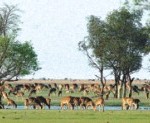Wildlife board suggests govt reduce number to two-thirds; hunting seen as option
 The Wildlife Advisory Board of the government has suggested downsizing the deer population at Nijhum Dwip to two-thirds as their number in the sanctuary has risen disproportionately to over 15,000 considering the island’s landscape.
The Wildlife Advisory Board of the government has suggested downsizing the deer population at Nijhum Dwip to two-thirds as their number in the sanctuary has risen disproportionately to over 15,000 considering the island’s landscape.
Now, what comes as a bad news for the island’s deer may turn out as a boon for hunters as the board thinks of allowing deer hunting as an option to reduce deer population in the serene island of 56 square kilometres. The board considers translocation of deer a tough proposition and so recommends allowing hunting.
The Bangladesh Wildlife (Protection) (Amendment) Act 1974 might be relaxed to allow one hunter to hunt two deer and this might earn Tk 50,000 in revenue, the wildlife board said.
At a meeting last March, the advisory board recommended reducing the number of deer to 10,000 and declare the island an exclusive zone for deer. It also recommended relaxing the laws on rearing deer on personal initiatives.
Only four pairs of deer were released in the forests of Nijhum Dwip in Noakhali back in 1978. In an atmosphere conducive to breeding, the number has now risen to over 15,000, causing shortage of food for their survival in dry seasons.
According to a census carried out in 2006, the number of deer on the island was 14,400, said forest officials.
There is no tiger in Nijhum Dwip forest. If there were tigers, the number of deer would have been a little less, they said.
The advisory board consisting of wildlife experts and senior forest officials observed that the size of deer population population in the island’s forest has already caused an imbalance compared to the number of deer in the Sundarbans.
The size of mangrove forests in Nijhum Dwip is around 5,000 acres (20 square kilometres) while the rest of the area is yet to be brought under forestation. The size of the Sundarbans is around 14.90 lakh acres where around 1.20 lakh deer live, officials at the Forest Department said.
It has sent the board’s recommendations to the forest and environment ministry. However, the ministry is yet to make any decision on it.
Another high powered committee led by the state minister for environment and forest will decide the fate of the recommendations, forest officials added.
Contacted by The Daily Star on August 19, acting Chief Conservator of Forest Abdul Motaleb said another meeting on Nijhum Dwip would be held soon to discuss the overall situation there.
Forest officials at Noakhali forest office earlier informed the central forest office about the food crisis in Nijhum Dwip forests in dry seasons.
“The staples for deer are leaves, fruits, seeds and mangrove roots of Keora. But its leaves and fruits go beyond the reach of the deer as the trees grow very tall,” Al Amin, a forest guard, told this correspondent during a visit to the island last week.
He said facing the shortage of food, deer leave forests and enter people’s homesteads and even cross the Hatia channel to migrate to nearby chars. The food crisis is relieved during the rainy season when Keora trees start bearing fruits, which fall to the ground, he said.
Herds of deer also come out of forests and eat grass. “But then there are thousands of cows and buffalos in Nijhum Dwip that live on grass, which deepens the food crisis for the deer,” Al Amin said.
In a letter to the Forest Department, the divisional forest officer at Noakhali has proposed releasing 10 pairs of monkeys in the forest. This will help solve the food crisis of deer as the monkeys will shake the trees and make fruits fall on the ground.
In 1978, a few monkeys were released in the forest, but all of them died during the cyclone in 1991, local forest officials said.
They said the government declared Nijhum Dwip as a national park in 2001, but work to transform it into a reserved forest is yet to begin.
Increasing human population on the island has also become a threat to the wildlife there. Migrating people did not settle there until 1970. But the population rose to 10,670 in 2001 and has reached 12,000 now.
The advisory board also recommended bringing an end to leasing land in Nijhum Dwip and taking initiatives for forestation.




















